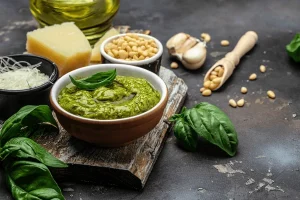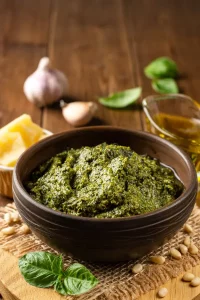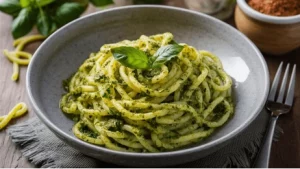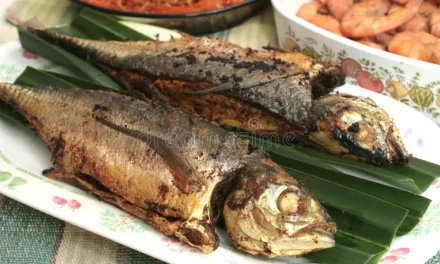Homemade Pesto Recipe and History
Homemade pesto is one of the most beloved and versatile sauces in Italian cuisine — fragrant, vibrant, and full of flavor. Traditionally made with fresh basil, garlic, pine nuts, Parmesan cheese, and olive oil, pesto is a celebration of simplicity and freshness. Its name comes from the Italian word pestare, meaning “to crush” or “to pound,” referring to the original method of preparing it with a mortar and pestle. This sauce, with its bright green hue and rich aroma, instantly elevates pasta, meats, vegetables, and breads.
The History of Pesto
Pesto originated in the Liguria region of northern Italy, particularly in Genoa, hence the full name Pesto alla Genovese. The recipe has roots that trace back to ancient Roman times when soldiers crushed herbs, garlic, and cheese to flavor their food. Over centuries, Ligurian cooks refined the recipe using locally abundant basil, olive oil, and pine nuts, crafting a sauce that came to define their regional identity.
By the 19th century, pesto had become a culinary icon, representing the Ligurian philosophy of using fresh, local ingredients to create rich, flavorful dishes. Today, pesto is enjoyed worldwide, with endless variations — from kale and arugula to sun-dried tomato and walnut versions — all paying homage to the original Genoese masterpiece.
Ingredients
- 2 cups fresh basil leaves (packed)
- ½ cup extra-virgin olive oil
- ⅓ cup pine nuts (or walnuts as an alternative)
- 2 cloves garlic, peeled
- ½ cup freshly grated Parmesan cheese
- Salt and freshly ground black pepper to taste
- Optional: a squeeze of lemon juice to preserve color and add brightness

Instructions
- Prepare the Basil and Nuts:
Wash and pat dry the basil leaves. Lightly toast the pine nuts in a dry pan over medium heat for 2–3 minutes until golden, stirring constantly to prevent burning. - Blend the Ingredients:
In a food processor or mortar and pestle, combine basil, toasted nuts, and garlic. Pulse several times until coarsely chopped. - Add the Cheese and Oil:
Add Parmesan cheese and begin to drizzle in the olive oil slowly while pulsing or stirring continuously. Continue blending until smooth but not overly puréed — pesto should retain a slightly coarse texture. - Season and Adjust:
Add salt, black pepper, and lemon juice (if using). Taste and adjust seasoning as needed. - Store Properly:
Transfer to a clean jar, top with a thin layer of olive oil to prevent oxidation, and refrigerate. It keeps well for up to one week or can be frozen for up to three months.
Tips for Perfect Pesto
- Use Fresh Ingredients: The key to authentic pesto is fresh basil and high-quality olive oil.
- Avoid Overheating: If using a food processor, blend in short bursts to avoid heating the basil, which can darken the color.
- Texture: True pesto should be thick yet spoonable, not runny or overly smooth.
- Cheese Options: For a sharper flavor, substitute half the Parmesan with Pecorino Romano.
- Nut Alternatives: Walnuts, almonds, or cashews can replace pine nuts for a different flavor and cost-friendly option.
Variations
- Arugula Pesto: Substitute half the basil with arugula for a peppery bite.
- Spinach or Kale Pesto: Great for a milder, nutrient-rich version.
- Sun-Dried Tomato Pesto (Pesto Rosso): Use dried tomatoes instead of basil for a sweet, tangy alternative.
- Vegan Pesto: Replace cheese with nutritional yeast and add a bit of lemon zest for brightness.
Nutritional Value (per 2 tablespoons)
Calories: 120 • Fat: 12 g • Carbohydrates: 1 g • Protein: 2 g
Pesto is rich in healthy monounsaturated fats from olive oil and antioxidants from basil. Pine nuts add protein and minerals like magnesium and zinc, while Parmesan contributes calcium and umami depth.
Serving Suggestions
Homemade pesto is wonderfully versatile:
- Toss it with pasta, gnocchi, or spaghetti squash.
- Spread it on sandwiches, bruschetta, or wraps.
- Use it as a marinade for chicken, shrimp, or fish.
- Drizzle it over roasted vegetables, soups, or baked potatoes.
- Stir into mayonnaise or yogurt for a quick dipping sauce.
For a traditional Italian presentation, toss pesto with trofie pasta and serve with boiled potatoes and green beans — a Ligurian favorite.
The Legacy of Pesto
Pesto remains one of the world’s most enduring sauces because it reflects Italy’s culinary philosophy: fresh, simple ingredients prepared with care. Every spoonful tells the story of Genoa’s coastal hills, where basil thrives under Mediterranean sunshine. Whether prepared in a marble mortar or a modern blender, homemade pesto continues to celebrate the art of pure, uncomplicated flavor — a timeless reminder that the best meals are those made with heart and heritage.
References:
- BBC Good Food. (2024). Classic Basil Pesto Recipe. Retrieved from https://www.bbcgoodfood.com
- Food Network. (2024). Homemade Pesto alla Genovese. Retrieved from https://www.foodnetwork.com
- Smithsonian Magazine. (2023). The History of Pesto and the Culinary Heritage of Genoa. Retrieved from https://www.smithsonianmag.com
- TasteAtlas. (2024). Traditional Ligurian Pesto alla Genovese. Retrieved from https://www.tasteatlas.com
- Harvard University Press. (2023). Mediterranean Cuisine: The Evolution of Italian Regional Dishes. Retrieved from https://www.harvard.com






